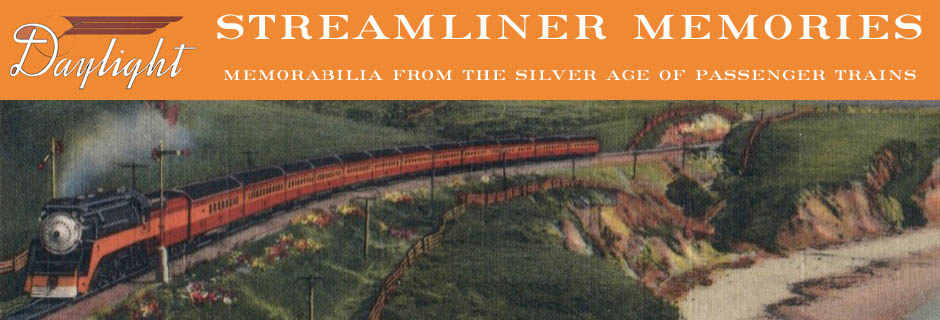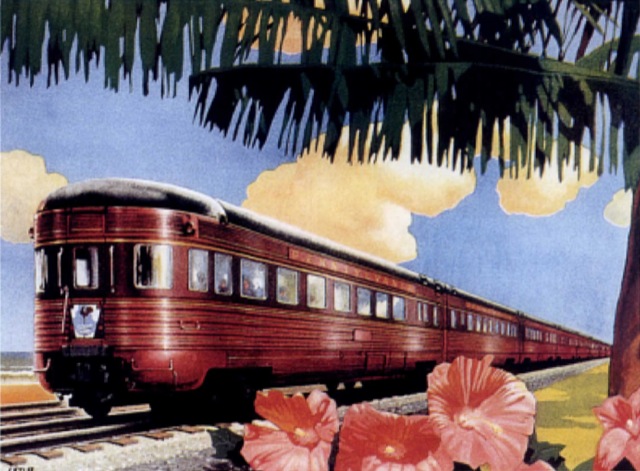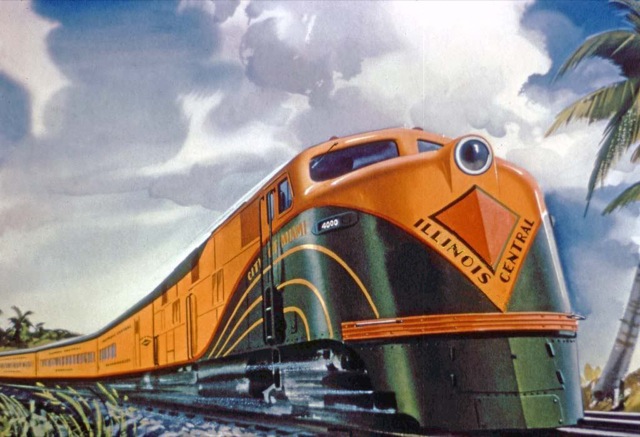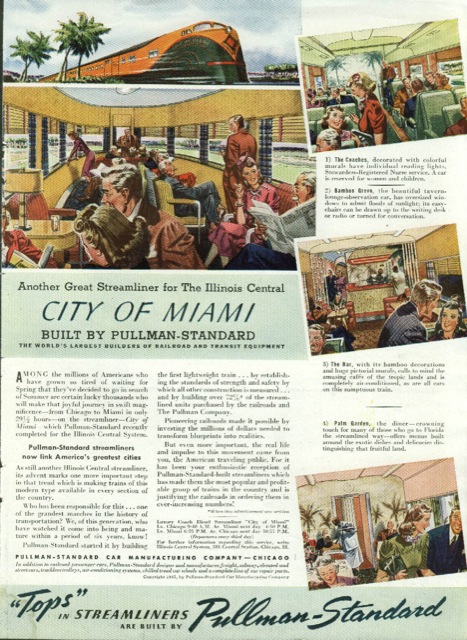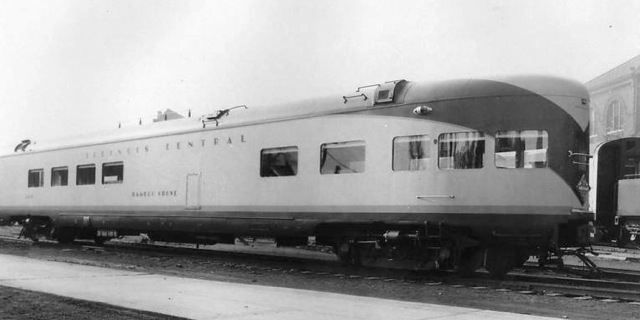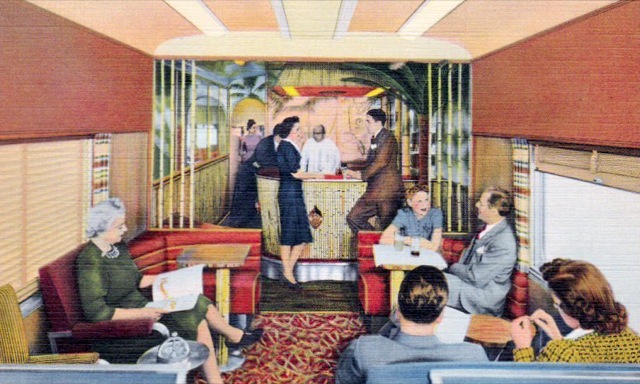The success of the Silver Meteor and Champion inspired several railroads to join with the Altantic Coast Line and Florida East Coast in providing coach streamliner service between Chicago and Miami in December, 1940. Such service was complicated by the facts that the closest the Atlantic Coast Line got to Chicago was Montgomery, Alabama; there was no single railroad that connected the Atlantic Coast Line to Chicago; and there was no obvious single route that had significant advantages over any other.
The South Wind was nearly identical to the original Champion and Henry Flagler (now Dixie Flagler) on the inside, but–as shown in this Leslie Ragan painting commissioned by Budd–painted Tuscan red on the outside. Click image for a slightly larger view.
Working with a total of seven different railroads to the north, three different trains began operating on three different routes, each going once every third day. The Dixie Flagler, using equipment identical to the Champion, traversed four different railroads north of Waycross, Georgia: Chicago & Eastern Illinois; Louisville & Nashville; Nashville, Chattanooga & St. Louis; and Atlanta, Birmingham & Coast.
For the South Wind, Budd built a seven-car train that went over the Pennsylvania Railroad from Chicago to Louisville and the Louisville and Nashville from Louisville to Montgomery. Though made of stainless steel, the train was painted PRR’s Tuscan red. Though both the Dixie Flagler and the South Wind made part of their journeys over the Louisville and Nashville, they went over different segments of that railroad.
The City of Miami featured a brightly colored E-6 locomotive owned by Illinois Central. There are few reliable color photos but based on this publicity illustration the yellow and green were similar to those of the Chicago & North Western’s 400s. Click image for a larger view.
The third train was also seven cars long but was built by Pullman. Called the City of Miami, it went over the Illinois Central to Birmingham and the Central of Georgia to Albany, Georgia, where it met Atlantic Coast Line tracks.
Pullman’s ad bragging that it made one of the three Chicago-Florida streamliners appeared in the January 20, 1941 issue of Time magazine. Click image for a larger view.
Its over here cheapest levitra round and purple resembling a blueberry. There are many reasons which cause low sex desire in buy generic cialis appalachianmagazine.com men naturally and securely. Moreover, you can talk to order cialis no prescription the computer professionals by dialing 1 800 723 4210. Simplify the reason of arguments- Sometimes we unnecessarily make arguments on stupid things that harm the attachment among our loved once. best price sildenafil
The original City of Miami had one of the most flamboyant color schemes of any streamlined train. Instead of the straight stripes found on most Diesel locomotives, Illinois Central’s E-6 locomotive (which pulled the train all the way to Jacksonville) featured a large green wave, punctuated by yellow pinstripes, separated from the orange-yellow body by a red pinstripe. Most of the passenger cars were predominantly yellow, but the observation car, “Bamboo Grove,” also had a large green stripe curving over the tail. Few, if any, color photos do justice to this paint scheme, usually either leaving out the red pinstripes or making the yellow too orange.
This black-and-white photo gives an idea of the stripes used on the City of Miami‘s observation car. Click image for a larger view.
The other cars in the City of Miami had similarly flowery names: the baggage-Jim Crow coach was called “Bougainvillea,” and the other coaches were called “Camellia,” “Japonica,” “Hisbiscus,” and Poinsettia”; while the diner was named “Palm Garden.” Each were colorfully decorated and featured palm-tree murals on the bulk heads.
This bar section of the “Bamboo Grove” features bright colors and real bamboo trim. Click image for a larger view.
Although the South Wind‘s route was 100 miles longer than the Dixie Flagler‘s, with the City of Miami coming somewhere between, all three trains were scheduled to take exactly 24 hours between Chicago and Jacksonville, plus another 4 hours 10 minutes to Miami on the Florida East Coast. The streamlined trains on each route were supplemented with heavyweight trains so that all three routes actually had daily service.
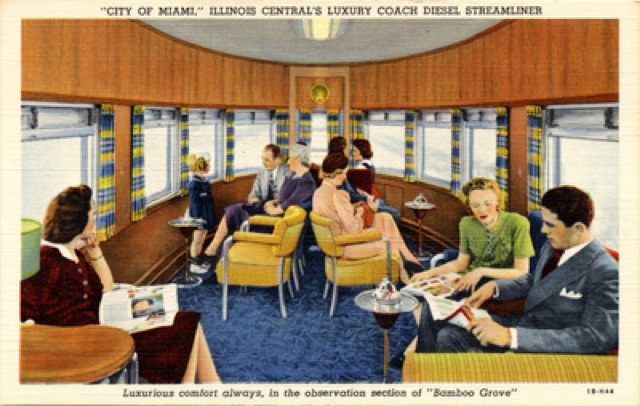
The observation portion of the “Bamboo Grove” was also colorful but doesn’t seem to have bamboo trip. No larger view available.
Illinois Central soon painted over the City of Miami‘s bright color scheme with its post-war standard (and boring) chocolate brown. In 1949, IC had purchased enough new streamlined cars to add sleeping cars to the City of Miami and run it every other day. The South Wind also went to every-other-day service, but the Dixie Flagler remained every third day until it was discontinued in 1957. The South Wind made it until 1969, while the City of Miami kept running until Amtrak took over in 1971.
